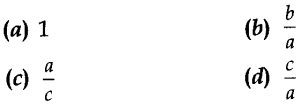Class 10 Maths MCQs Chapter 5 Arithmetic Progressions
Class 10 Maths MCQs Chapter 5 Arithmetic Progressions
1. The nth term of an A.P. is given by an = 3 + 4n. The common difference is
(a) 7
(b) 3
(c) 4
(d) 1
2. If p, q, r and s are in A.P. then r – q is
(a) s – p
(b) s – q
(c) s – r
(d) none of these
3. If the sum of three numbers in an A.P. is 9 and their product is 24, then numbers are
(a) 2, 4, 6
(b) 1, 5, 3
(c) 2, 8, 4
(d) 2, 3, 4
4. The (n – 1)th term of an A.P. is given by 7,12,17, 22,… is
(a) 5n + 2
(b) 5n + 3
(c) 5n – 5
(d) 5n – 3
5. The nth term of an A.P. 5, 2, -1, -4, -7 … is
(a) 2n + 5
(b) 2n – 5
(c) 8 – 3n
(d) 3n – 8
6. The 10th term from the end of the A.P. -5, -10, -15,…, -1000 is
(a) -955
(b) -945
(c) -950
(d) -965
7. Find the sum of 12 terms of an A.P. whose nth term is given by an = 3n + 4
(a) 262
(b) 272
(c) 282
(d) 292
8. The sum of all two digit odd numbers is
(a) 2575
(b) 2475
(c) 2524
(d) 2425
9. The sum of first n odd natural numbers is
(a) 2n²
(b) 2n + 1
(c) 2n – 1
(d) n²
10. If (p + q)th term of an A.P. is m and (p – q)tn term is n, then pth term is

11. If a, b, c are in A.P. then (a−b)/(b−c) is equal to

12. The number of multiples lie between n and n² which are divisible by n is
(a) n + 1
(b) n
(c) n – 1
(d) n – 2
13. nth term of the sequence a, a + d, a + 2d,… is
(a) a + nd
(b) a – (n – 1)d
(c) a + (n – 1)d
(d) n + nd
14. The 10th term from the end of the A.P. 4, 9,14, …, 254 is
(a) 209
(b) 205
(c) 214
(d) 213
15. If 2x, x + 10, 3x + 2 are in A.P., then x is equal to
(a) 0
(b) 2
(c) 4
(d) 6
16. The sum of all odd integers between 2 and 100 divisible by 3 is
(a) 17
(b) 867
(c) 876
(d) 786
17. If the numbers a, b, c, d, e form an A.P., then the value of a – 4b + 6c – 4d + e is
(a) 0
(b) 1
(c) -1
(d) 2
18. If 7 times the 7th term of an A.P. is equal to 11 times its 11th term, then 18th term is
(a) 18
(b) 9
(c) 77
(d) 0
19. The sum of the first 15 multiples of 8 is
(a) 920
(b) 860
(c) 900
(d) 960
20. Next term of the AP √2, 3√2, 5√2, ……. is
(a) 2√7
(6) 6√2
(c) 9√2
(d) 7√2
21. First four terms of the sequence an = 2n + 3 are
(a) 3, 5, 7, 9
(b) 5, 7, 9, 11
(c) 5, 8, 11, 14
(d) 1, 3, 5, 7

22. 20th term of the AP -5, -3, -1, 1, is
(a) 33
(b) 30
(c) 20
(d) 25
23. If nth term of an AP is 7 – 4n, then its common difference is
(a) 4
(b) -4
(c) 3
(d) 11
24. If the sum of first n terms of an AP is An + Bn² where A and B are constants. The common difference of AP will be
(a) A + B
(b) A – B
(c) 2A
(d) 2B
25. In an Arithmetic Progression, if a = 28, d = -4, n = 7, then an is:
(a) 4
(b) 5
(c) 3
(d) 7
26. If a = 10 and d = 10, then first four terms will be:
(a) 10, 30, 50, 60
(b) 10, 20, 30, 40
(c) 10, 15, 20, 25
(d) 10, 18, 20, 30
27. The first term and common difference for the A.P. 3, 1, -1, -3 is:
(a) 1 and 3
(b) -1 and 3
(c) 3 and -2
(d) 2 and 3
28. 30th term of the A.P: 10, 7, 4, …, is
(a) 97
(b) 77
(c) -77
(d) -87
29. 11th term of the A.P. -3, -1/2, 2 …. Is
(a) 28
(b) 22
(c) -38
(d) -48
30. The missing terms in AP: __, 13, __, 3 are:
(a) 11 and 9
(b) 17 and 9
(c) 18 and 8
(d) 18 and 9
31. Which term of the A.P. 3, 8, 13, 18, … is 78?
(a) 12th
(b) 13th
(c) 15th
(d) 16th
32. The 21st term of AP whose first two terms are -3 and 4 is:
(a) 17
(b) 137
(c) 143
(d) -143
33. If 17th term of an A.P. exceeds its 10th term by 7. The common difference is:
(a) 1
(b) 2
(c) 3
(d) 4
34. The number of multiples of 4 between 10 and 250 is:
(a) 50
(b) 40
(c) 60
(d) 30
35. 20th term from the last term of the A.P. 3, 8, 13, …, 253 is:
(a) 147
(b) 151
(c) 154
(d) 158
36. The 10th term of the AP: 5, 8, 11, 14, … is
(a) 32
(b) 35
(c) 38
(d) 185
37. In an AP, if d = -4, n = 7, an = 4, then a is
(a) 6
(b) 7
(c) 20
(d) 28
38. If the 2nd term of an AP is 13 and the 5th term is 25, then its 7th term is
(a) 30
(b) 33
(c) 37
(d) 38
39. Which term of the AP: 21, 42, 63, 84,… is 210?
(a) 9th
(b) 10th
(c) 11th
(d) 12th
40. What is the common difference of an AP in which a18 – a14 = 32?
(a) 8
(b) -8
(c) -4
(d) 4
41. The sum of first 16 terms of the AP: 10, 6, 2,… is
(a) –320
(b) 320
(c) –352
(d) –400
42.The nth term of an A.P. is given by an = 3 + 4n. The common difference is
(a) 7
(b) 3
(c) 4
(d) 1
43. If p, q, r and s are in A.P. then r – q is
(a) s – p
(b) s – q
(c) s – r
(d) none of these
44. If the sum of three numbers in an A.P. is 9 and their product is 24, then numbers are
(a) 2, 4, 6
(b) 1, 5, 3
(c) 2, 8, 4
(d) 2, 3, 4
45. The (n – 1)th term of an A.P. is given by 7,12,17, 22,… is
(a) 5n + 2
(b) 5n + 3
(c) 5n – 5
(d) 5n – 3
46. The nth term of an A.P. 5, 2, -1, -4, -7 … is
(a) 2n + 5
(b) 2n – 5
(c) 8 – 3n
(d) 3n – 8
47.The 10th term from the end of the A.P. -5, -10, -15,…, -1000 is
(a) -955
(b) -945
(c) -950
(d) -965
48.Find the sum of 12 terms of an A.P. whose nth term is given by an = 3n + 4
(a) 262
(b) 272
(c) 282
(d) 292
49. The sum of all two digit odd numbers is
(a) 2575
(b) 2475
(c) 2524
(d) 2425
50. nth term of the sequence a, a + d, a + 2d,… is
(a) a + nd
(b) a – (n – 1)d
(c) a + (n – 1)d
(d) n + nd
Class 10 Maths MCQs Chapter 5 Arithmetic Progressions
Class 10 Maths MCQs Chapter 5 Arithmetic Progressions
MCQ VIDEOS ALL CHAPTERS CLASS 10 MATHShttps://www.youtube.com/watch?v=-eBlHyBxjLg&list=PL2uPMjJCHErQZZNipbsnagBqPrCU_WRN8

